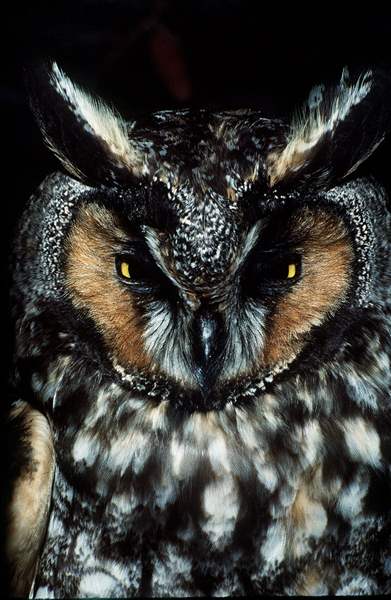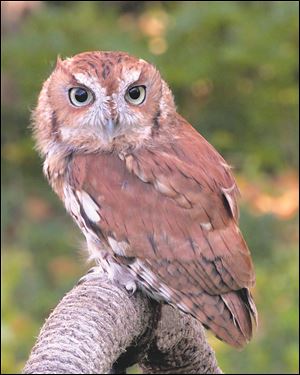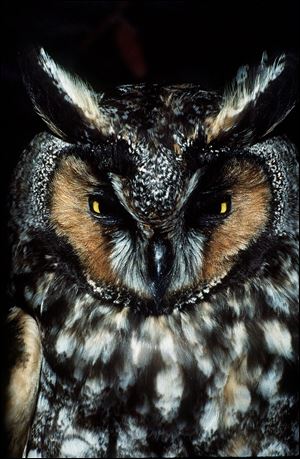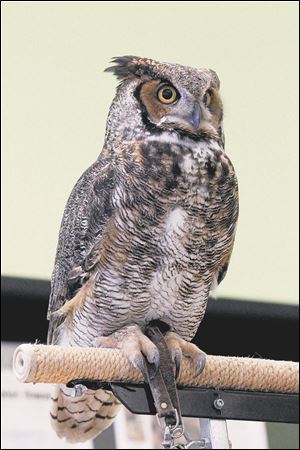
Symbiotic relationship between owls, woodpeckers helps assess health, viability of their habitats
12/22/2013
.
ART WEBER

Eastern Screech Owl - Megascops asio.
They are not adversaries, but at first glance, they could hardly be considered great friends.

.
Owls are birds of prey, stealthy hunters of the night that strike with powerful talons to satisfy a fierce, carnivorous appetite. Woodpeckers are much more methodical workers, endlessly jumping from tree to tree and hammering away to forage for grubs and insects, while also using the holes they excavate to build nests.
Their common bond would seem to be limited to feathers and flight, but they have a much more complex and symbiotic relationship, and one that is valued in assessing the health and viability of certain habitats.
DIGITAL MAGAZINE: Download today's Toledo Magazine page
Photographer and naturalist Paul Bannick of Seattle has spent thousands of hours traversing the wild places on the North American continent, on foot, by kayak, and on snowshoes, and has chronicled the way these two families of birds tell us much about the places where they live. Included in that list of owl and woodpecker ecosystem duplexes is the Oak Openings region west of Toledo.

A Great Horned Owl in the Back to The Wild presentation at Rossford Public Library on May 9, 2012.
Mr. Bannick, whose stunning photos of these birds are currently on display at the National Center for Nature Photography at Secor Metropark in Oak Openings, details in his book The Owl and The Woodpecker the critical roles they play in essentially providing us with a readout of the vital signs of sensitive ecosystems.
The author describes the roles owls and woodpeckers play as indicator species and as keystone species in vital habitats. Some species are highly dependent on critical natural elements of their environment, such as old growth trees, and when these elements are degraded, vulnerable owls and woodpeckers are severely affected, Mr. Bannick said. The health of their populations provides a measure of the health of the entire ecosystem, thus making them an indicator.
The keystone species, as Mr. Bannick describes it, improves habitat that will support a wide range of other species. There are a multitude of insects, amphibians, mammals, and many birds other than owls that rely on woodpeckers to create the cavities they need for nesting and food.
"Owls are at the top of their food web and that often makes them indicators attesting to the health of the ecosystems they inhabit," Mr. Bannick said. "Woodpeckers, while often indicator species as well, are also keystone species, since they create sap-wells and excavations that benefit many other animals that use these cavities, including the 10 species of owls that use their cavities for nest sites."
Mr. Bannick visited Oak Openings recently, and found what he called "an area incredibly rich with woodpeckers," with multiple varieties and a large population of Eastern Screech Owls. The holes woodpeckers open in trees provide housing and nutrition for the other inhabitants of places such as Oak Openings.

"There is such a diversity of habitat in that region," Mr. Bannick said. "And you've got several species of woodpeckers living there, and all of them create cavities in trees — cavities that the Eastern Screech Owls here benefit from."
Oak Openings is a band of sandy soil that stretches through Henry and Fulton counties and across the Michigan line, spread out several miles wide in most areas. The Oak Openings region is one of the most rare ecosystems on the planet, and tabbed by the Nature Conservancy as "One of America's Last Great Places."
Oak Openings is home to more endangered native plant species than any other place in the Buckeye State, and home to owls and woodpeckers. Visitors to Secor Metropark might catch a glimpse of owls hunting at dusk, or hear the rapid-fire pounding of woodpeckers echo through the scattered forest during the day. The exhibit at the National Center for Nature Photography includes images of the owls and woodpeckers that inhabit Oak Openings, and many more of the 19 owl and 22 woodpecker species that call North America home.
"If this were an exhibit on wood rats or mosquitoes, I'm not sure people would be all that excited, but these are such beautiful birds, besides being so important," said Art Weber, a nature photographer and writer who served as Metroparks public information manager for three decades. "A number of these woodpeckers and owls prefer an area like Oak Openings, so we can see this unique relationship play out right here every day."
Mr. Bannick, who has observed owls and woodpeckers in the Arctic tundra, the desert, the grasslands and shrub steppe, western forests, eastern forests and boreal forests, and in the pine and oak woodlands, said that for many owls and woodpeckers, the connections are especially pronounced.
"Most people are surprised by the relationship and the degree to which it goes," Mr. Bannick said. "People see an owl in a hole, but don't think about where that hole came from. But this relationship reminds us that everything is connected."